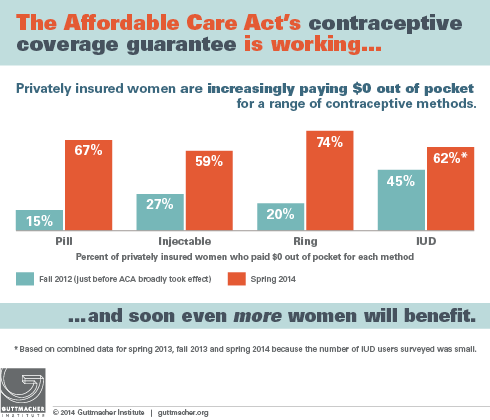The proportion of privately insured U.S. women who paid zero dollars out of pocket for oral contraceptive pills increased sharply, from 15% to 67%, between the fall of 2012 (before the ACA’s contraceptive coverage requirement took effect for most women) and the spring of 2014, according to a new Guttmacher study published in the journal Contraception. The study found that the proportion of women who paid nothing out of pocket also increased among those using the vaginal ring (from 20% to 74%) and among those using injectable contraceptives (from 27% to 59%). For women using the IUD, the proportion increased from 45% in the fall of 2012 to 62% in the three subsequent waves of the study combined.

"This analysis shows that the contraceptive coverage guarantee under the ACA is working as intended," says Adam Sonfield, senior public policy associate at the Guttmacher Institute and lead author of the study. "Large numbers of women are now able to obtain highly effective birth control methods without co-pays or deductibles, making it easier for them to choose the method they can use most consistently and effectively to avoid an unplanned pregnancy."
However, the study notes that there are still gaps in coverage, partly due to federal guidelines that allow insurers to charge co-payments in limited situations (e.g., for brand name drugs with generic equivalents or when a woman receives services from an out-of-network provider) and that exempt some employer-sponsored health plans on religious grounds. Gaps also result from some private health plans improperly requiring patient cost-sharing in circumstances where they shouldn’t. A previous policy analysis explores this issue in more detail, and recommends greater enforcement by state and federal policymakers to ensure these gaps are closed.
These study findings make clear that the ACA’s contraceptive coverage guarantee has had a substantial and rapid impact on eliminating out-of-pocket costs among privately insured women using contraceptives.
"That these benefits continue to accrue so quickly is remarkable, and shows that the contraceptive coverage guarantee is meeting a real demand," says Sonfield. "Its impact will only continue to grow as its protections are phased in. The proportion of workers enrolled in 'grandfathered' plans—existing plans given a temporary reprieve from many of the ACA's rules—has been declining rapidly, as Congress intended, from 48% in 2012 to just 26% in 2014, according to the Kaiser Family Foundation."
The Guttmacher analysis draws on data from its Continuity and Change in Contraceptive Use study, which collected information from a national survey of women aged 18–39 at four points in time, beginning in fall 2012 (before the contraceptive coverage requirement took effect for most women), and ending in spring 2014.
Click here for "The Impact of the Federal Contraceptive Coverage Guarantee on Out-of-Pocket Payments for Contraceptives: 2014 Update."
Click here for the previous analysis, "Changes in Out-of-Pocket Payments for Contraception by Privately Insured Women During Implementation of the Federal Contraceptive Coverage Requirement."
For more information:
Facts on Contraceptive Use in the United States
Video: Benefits of Contraceptive Use
KnowledgePanel® Methodology
The survey on which this study is based was conducted using GfK’s web-enabled KnowledgePanel®, a probability-based panel designed to be representative of the U.S. population. Initially, participants are chosen scientifically by a random selection of telephone numbers and residential addresses. Persons in selected households are then invited by telephone or by mail to participate in the web-enabled KnowledgePanel®. For those who agree to participate, but do not already have Internet access, GfK provides at no cost a laptop and ISP connection. People who already have computers and Internet service are permitted to participate using their own equipment. Panelists then receive unique log-in information for accessing surveys online, and then are sent e-mails throughout each month inviting them to participate in research.